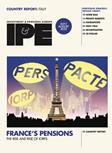The approval by the Italian lower house of a controversial pensions reform brought at least a temporary respite to a government battered by criticism by its EU partners over its failure to cut its budget deficit and by internal discord over plans to both cut the deficit and taxes.
The measure is also intended to boost Italy’s underdeveloped private supplementary pension provision sector, according to seasoned analyst of the market, Guido Blasco of consultant Hewitt. “Pension funds never really took off in Italy – in my opinion because there was never a need given our generous social security system – so the government decided to act in two ways,” Blasco says. “First, unless an employee decides otherwise, the almost 7% of their total pay that is currently invested in a TFR, a deferred compensation item retained on the employer's books, will be invested in a pension. This amounts to about E12-13bn every year. Second, the government has stated that all the pension funds - closed, open, individual accounts - will compete on the same basis. Currently, workers wanting to invest in a pension fund must enrol in specified funds linked to their occupation. The reform enables them to select from among competing pension funds.”
There are also suggestions that further competition may come from the National Institute for Social Provision (INPS), which might take the contributions of employees who do not select a pension fund and do not signify in writing that they do not want their money to be invested in a pension fund.
However, this is not clear. “If an employee doesn’t decide anything about his TFR and there is an existing sector fund, the money should go into the sector fund,” notes Fonchim operations director Andrea Girardelli. “But if there is no fund for that sector, then nobody knows where the money will go.”
And this lack of clarity over key issues highlights what appears to be a defining characteristic of pension reform Italian style. “Every three years or so we announce a pension reform – we like it,” notes Hewitt’s Blasco. “There is always a need for a follow-up as the initial reforms are never strong enough to resolve the problems because it is a politically sensitive area where compromises are always required. We started in 1993, made another in 1996, followed that with an adjustment in 1999 and now we have just done it again.”
But often the introduction of new measures is accompanied by the granting of exceptions. The 1993 law, for example, banned pension funds from investing in certain areas, including direct investment in real estate, but allowed pre-existing pension funds, the so-called ‘pre-esistente’, to continue to do so. So the pension fund of Unicredito Italiano, one of the pre-esistente, has about 63% of its portfolio in real estate, both commercial and residential, and administers the direct investments itself. It delivers a reliably constant return of 5-6% net per year which helped towards a 2003 return of 8% and has since boosted results in an otherwise disappointing first-half 2004 financial market performance, which saw returns on bonds and equities of about 2%.
The Unicredito Italiano pension fund anticipated the rise in interest rates and switched the duration of bonds in its portfolio earlier this year, overweighting the very short and long parts of the curve and declining to invest in 1-3 years duration paper because it was less attractive than leaving the money in its bank account. It also has a flexible hedge fund with a target of Euribor +1%, it overweighted corporate bonds and managed to cover the rate risk with daily trading on the rates. In addition, it increased its holdings in the high-yield sector, but not in anything with a rating below BBB.
In the longer term the fund intends to switch the 60:40 ratio between real estate and bond/equities to 50:50 or even 45:55, retaining its current real estate portfolio and increasing the bond and equities element by directing new contributions into those areas.
“Over the past year there has been an evolution of schemes from mono- to multi-compartments, from a pension scheme with a single portfolio, a unique risk, to schemes with different portfolios to permit the choice of different risk yield profiles,” notes Luigi Ballanti, director of the Association for the Development of Pension Funds (Mefop). “Pension funds may decide to have three or four portfolios with different risks and asset classes.
“There have also been moves in the area of corporate governance,” Ballanti notes. “In the past no particular attention was paid to this area, but now it is seen to be of increasing importance.”
But the governance picture is complicated by the multiplicity of regulators. Private pension funds catering to the employed are overseen by Covip. But the 19 casse previdenziali, which operate as pension funds for self-employed professionals, are overseen for different issues by the ministers of the economy, treasury and labour and welfare, and a juridical court. Like pre-esistente pension funds, casse previdenziali can invest in property, although they report that a high tax regime depresses its performance as an asset class.
“This is typical of financial market regulation in Italy where supervisory responsibilities are divided between a plethora of agencies, including the anti-trust authorities, the central bank and the stock exchange commission,” says a resigned player who did not want to be identified. “A bill was tabled in parliament January in an attempt to tidy up the system as a matter of urgency after the Parmalat and Cirio debacles, but it has still not been passed.”
Will the European Pensions Directive help bring some order into the Italian system? Mefop’s Ballanti notes that the directive’s prudent person principle will offer pension funds more investment freedom but will also mean that they carry more responsibility. But Fonchim’s Girardelli doubts that a major element, to allow the portability of funds from one country to another, requires a fiscal harmonisation that is not yet on the agenda.























No comments yet